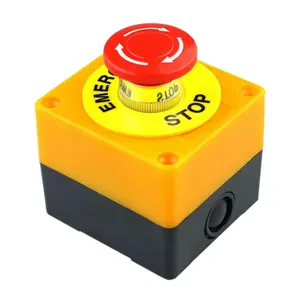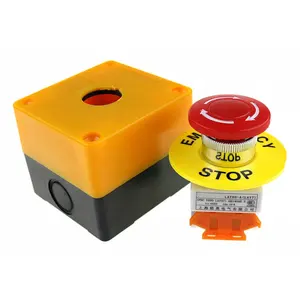
All categories
Featured selections
Trade Assurance
Buyer Central
Help Center
Get the app
Become a supplier

(1990 products available)





































The elevator emergency button is a crucial safety component in any elevator system. While the text below provides a comprehensive overview of its functions, there are also different types of elevator emergency buttons, which include:
Emergency Stop Button
This elevator emergency button is usually located inside the elevator car. It is typically a red button that is easily visible and identifiable. Pressing this button will stop the elevator in transit and hold it at the floor where it is currently located. It is mainly used to halt the elevator in case of emergencies, such as malfunctioning or unsafe conditions. The emergency stop button helps prevent further movement and potential accidents.
Emergency Alarm Button
This button is usually red. It is located inside the elevator and is distinct from the emergency stop button. Pressing this button will activate an alarm that will alert people in the building to the emergency situation. It may also notify the elevator personnel/ operators. This button is essential for communication during an emergency, ensuring that help can arrive as quickly as possible.
Emergency Phone/Intercom
This is an elevator emergency button that is typically more advanced. It comprises a dedicated emergency phone line or intercom system located within the elevator car. For instance, when an individual is trapped inside the elevator during an emergency, they can use the emergency phone or intercom to contact emergency services directly. The emergency phone or intercom has a built-in phone or intercom system that connects directly to emergency services. It provides a reliable means of communication when other methods may not be available.
Emergency Power-Off Button
This elevator emergency button is usually located outside the elevator car. It is generally red and has a distinctive sign. It is meant to be used only in emergencies by authorized personnel. Pressing this button will turn off power to the elevator, bringing it to a complete stop and holding it on the floor where it is located. This button is ideal for emergency situations where stopping the elevator and holding it in place is necessary, such as in case of fire or other hazardous conditions. It is also used when the elevator needs to be completely powered off for maintenance or emergency rescue operations.
Elevator emergency buttons are critical safety devices within lifts. They serve a crucial function in ensuring the safety of passengers. They can also be used to communicate with emergency services in the event of an emergency.
Features of an elevator emergency button include:
Emergency Call Button
This button is pressed during an emergency. It is responsible for connecting the elevator passengers to emergency personnel. The emergency call button is easily recognizable. It is often marked with a distinctive graphic symbol or text. For instance, a help symbol or an alarm symbol.
Emergency Stop Button
This button halts the elevator in emergencies. It is usually red and is located within the cab on control panels. Pressing this button will stop the elevator from moving. This ensures the safety of passengers in case of malfunction or if they want to stop the elevator in an emergency.
Alarm Button
This button activates a loud alarm within the elevator. It is primarily designed to alert people outside the elevator. For instance, building staff or emergency personnel. In turn, this ensures that help can be provided quickly to passengers who may be in distress or have been trapped in the elevator.
Emergency Light Button
These buttons are essential for visibility during emergencies. They are responsible for illuminating the elevator cabin. This illumination aids passengers in seeing and navigating. This is especially when they are in a panic or if visibility is low.
Emergency Phone
This is an essential device that allows passengers to communicate directly with emergency personnel. In some cases, these phones may have autodial capabilities. This ensures a swift connection to emergency services. An emergency phone enhances security, ensuring passengers can seek immediate assistance when needed.
Emergency Power Supply
These are backup batteries. They ensure that essential functions of the elevator continue to operate during a power failure. Emergency power supplies allow for the safe evacuation of passengers. It also facilitates communication with emergency services. This enhances security and minimizes the risk of passengers being stranded in emergencies.
Emergency Ventilation
These are features that ensure the circulation of air within the elevator. They are primarily designed to prevent suffocation. This is particularly in cases where passengers have been trapped for extended periods. Emergency ventilation enhances the comfort of passengers, thereby reducing panic and anxiety levels. This contributes significantly to the overall safety and well-being of passengers in distress situations.
Emergency elevator buttons are a crucial safety feature in various scenarios, including:
Passenger Elevators in Buildings:
Emergency Help: If passengers get stuck between floors, they can press the emergency button to alert building staff or emergency responders.
Immediate Assistance: In case of medical emergencies or urgent needs, pressing the emergency button can prioritize their rescue.
Construction Site Hoists:
Worker Safety: Site personnel using hoists to transport materials or workers can rely on emergency buttons for prompt assistance in case of incidents.
Incident Reporting: Emergency buttons help report and address any safety concerns or malfunctions during transportation.
Service Elevators:
Emergency Button: Service elevators used for transporting goods in commercial or industrial settings require emergency buttons to ensure the safety of personnel and goods, especially in high-traffic areas.
Location Awareness: Emergency buttons may have features to indicate the elevator's location and status to facilitate rescue.
Public Transportation Elevators:
Accessibility: Elevators in train stations, bus terminals, and public transit facilities cater to individuals with disabilities and may require emergency buttons for immediate assistance.
Stranded Passengers: Emergency buttons can help rescue stranded passengers, especially those using mobility aids.
Parking Garage Elevators:
Isolation: In some cases, such as parking garages, passengers may be isolated in the elevator, making emergency buttons crucial for alerting help.
Malfunction Resolution: Emergency buttons can assist in resolving issues like getting stuck in the garage.
Hospital Elevators:
Patient and Medical Staff Safety: Hospitals rely heavily on elevators for patient transport and medical equipment. Emergency buttons ensure timely assistance in critical situations.
Medical Emergencies: Hospital elevators may have specialized emergency buttons for medical emergencies requiring immediate vertical transport.
Elevators in High-Rise Buildings:
High-Rise Challenges: In high-rise buildings, emergency buttons are vital due to the complexity of rescues at great heights.
Fire and Emergency Situations: Firefighters and emergency personnel may use these buttons to access specific floors during emergencies.
When choosing an emergency elevator button, it is important to consider a few aspects. Here are some of them:
Button type
There are many types of emergency buttons, and it is essential to select the right one. Some of the available types include call buttons, stop buttons, alarm buttons, and intercom buttons.
Button location
When selecting an emergency button for an elevator, it is important to consider the location where it will be installed. The emergency button should be easily accessible to the passengers and within reach.
Button visibility
The emergency button should be visible to passengers. It should be well illuminated and marked. Consider the color of the emergency button; red is a popular choice because it attracts attention in an emergency.
Button durability
Choose an emergency button that can withstand heavy usage. The button should be built with robust materials like stainless steel. Also, check the button's rating to ensure it is suitable for use in elevators.
Button features
Look for an emergency button with useful features. For instance, an elevator emergency alarm button with a built-in LED light will make it easier for people to see in low-light conditions. An elevator emergency button with a loud alarm will alert people nearby.
Compliance
Ensure the emergency button complies with local regulations. For example, the elevator emergency button must meet the requirements of the Americans with Disabilities Act (ADA).
Testing and maintenance
The emergency alarm buttons should be tested and inspected regularly to ensure they are in good working condition. When choosing an emergency button, consider the testing and maintenance requirements to ensure they comply with local regulations.
Cost
When buying an emergency elevator button in bulk, it is important to consider the cost to ensure it fits within the budget. However, while considering the cost, do not compromise on quality. Ensure the button is reliable and of good quality.
Q1: What is the most important elevator emergency button?
A1: The most important emergency button is the emergency stop button. This button is crucial because, in an emergency, the elevator can be stopped on a specific floor so people can safely exit.
Q2: What is the red button in the elevator?
A2: The red button is usually the emergency stop button. When pressed, the elevator will stop and hold in the location until help is provided. This button should only be used in emergencies.
Q3: What are the three emergency buttons?
A3: The emergency stop button is red. The alarm button, which can be pressed to make noise and alert people on the floor, and the emergency phone button, which dials a predetermined number to notify emergency personnel.
Q4: Where is the emergency button in the elevator?
A4: The emergency button is usually located near the control panel. It can be the alarm button or the emergency phone. The emergency stop button is usually only found in the elevator control panel.
Q5: What is the elevator emergency button made of?
A5: The elevator emergency button is usually made of durable plastic or metal. It is designed to withstand repeated pressing and provide a tactile response. The button often has a waterproof cover.